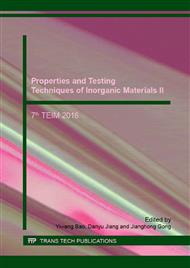p.174
p.179
p.184
p.189
p.194
p.199
p.204
p.210
p.215
Mechanism of Controlled Pore Structure of Quartz Pore Gradient Materials
Abstract:
Pore gradient material has obvious uneven, making the material porosity, pore size and strength changes with the thickness of the material exhibits a special distribution, pore gradient material is therefore in the chemical industry, environmental protection, metallurgy, food, biotechnology and other industries widely used, it is a very promising new material. In this paper, low-grade quartz sand as the main raw material, by adding auxiliary ingredients, using foam deposition method, the pore graded material were prepared. Through experimental results and analysis, the conclusions can be obtained, quartz pore gradient material body after sintering at 1300¡æ posing obvious gradient structure. When the ratio of water to 1.4 and 1.5, the sample can be observed that there is a clear gradient structure. Considering the combination of price, quality quartz pore gradient material should be water feed ratio of 1.4, the sintering temperature is 1300 ¡æ more appropriate, the porosity of prepared quartz graded materials was 32.45%.
Info:
Periodical:
Pages:
194-198
Citation:
Online since:
January 2017
Authors:
Price:
Сopyright:
© 2017 Trans Tech Publications Ltd. All Rights Reserved
Share:
Citation:


